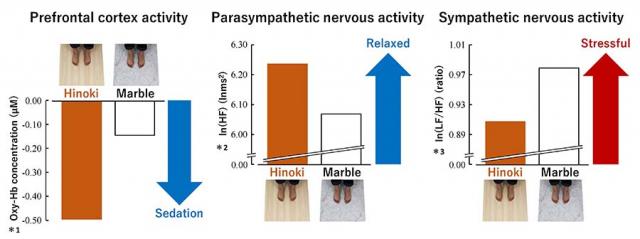Home > Research > Research Results > Research Results 2018 > The Brain and Body Relax when the Feet are in Contact with Wood
Update:December 21, 2018
Main content starts here.
The Brain and Body Relax when the Feet are in Contact with Wood
| Article title |
Physiological Effects of Touching the Wood of Hinoki Cypress (Chamaecyparis obtusa) with the Soles of the Feet |
|---|---|
| Author (affiliation) |
Harumi Ikei (a), Chorong Song (b), Yoshifumi Miyazaki (b) (a) Department of Wood Engineering, FFPRI, Tsukuba, Ibaraki, Japan. |
| Publication Journal |
International Journal of Environmental Research and Public Health, 15(10):2135, September 2018, DOI:10.3390/ijerph15102135( External link ) |
| Content introduction |
Based on experience, wood, a typical interior design material, feels pleasant to touch by hand or foot. Our previous studies have demonstrated that touching Hinoki cypress (Chamaecyparis obtusa) or white oak (Quercus alba) wood by hand can induce a state of physiological relaxation. However, the effect of the same tactile stimulus to the foot has not been tested. This study aimed to demonstrate the relaxation effect of contact with a wooden material using brain and autonomic nervous activities as physiological indices. We examined the brain and autonomic nervous activities of 19 female university students in their 20s while the soles of their feet were in contact with a Hinoki cypress material for 90 seconds. As an indicator of brain activity, the blood flow in the left and right prefrontal cortices was measured using near-infrared spectroscopy (NIRS). *1) The blood flow in the prefrontal cortex decreases during the relaxation state. With regard to autonomic nervous activity, we separately examined the parasympathetic nervous activity, which increases in the relaxation state, and sympathetic nervous activity, which increases under stress, by analyzing heart rate variability. *2) Our results show that having the soles in contact with a Hinoki cypress material reduced the blood flow in the left and right prefrontal cortices, increased the parasympathetic nervous activity, and decreased the sympathetic nervous activity. This indicates that this tactile stimulus to the soles of the feet relaxes both the brain and body. This study scientifically demonstrated the relaxation effect of contact with a wooden material, which was traditionally known before, and provided scientific evidence for the “goodness of wood.” We plan to continue accumulating data on the physiological relaxation effect domestic wooden materials can induce through the five senses and ultimately help promote the use of domestic wood.
*1) Because brain activity requires oxygen, an active region of the brain receives an ample supply of oxy-hemoglobin (oxy-Hb)-rich arterial blood. NIRS is a method wherein near-infrared light, which appears reddish, is projected through the brain, and the reflected light is measured. When the blood supply is abundant, it absorbs much of the near-infrared light, and the reflection decreases. In contrast, a low blood supply decreases the absorption and increases the reflection. NIRS is a method that measures the extent of light reflection used to determine blood concentration and evaluate brain activity level. *2) Although the heartbeat is generally believed to remain regular, the heartbeat interval (RR interval) tends to fluctuate based on the autonomic nervous activity. A frequency analysis of such fluctuation enables the calculation of the high-frequency (HF) component of the heart rate variability (HRV) (which reflects the increased parasympathetic nervous activity in the relaxation state) and the ratio of the low-frequency (LF) component against the high-frequency component (LF/HF) (which reflects the increased sympathetic nervous activity under stress). This is called HRV, which is currently used more commonly than blood pressure or pulse rate to measure the autonomic nervous activity. Mean values of the 19 subjects. Reported in the Int J Environ Res Public Health 15(20), 2135, 2018 have been revised. *1: A decrease in the oxy-hemoglobin concentration is associated with reduced blood flow and brain sedation. *2: The high-frequency (HF) component reflects the increased parasympathetic nervous activity in the relaxation state.. *3: The ratio of the low-frequency component against the high-frequency component (LF/HF) reflects the increased sympathetic nervous activity under stress. |
Copyright © Forest Research and Management Organization. All rights reserved.

